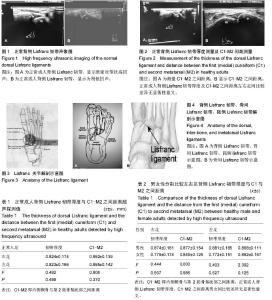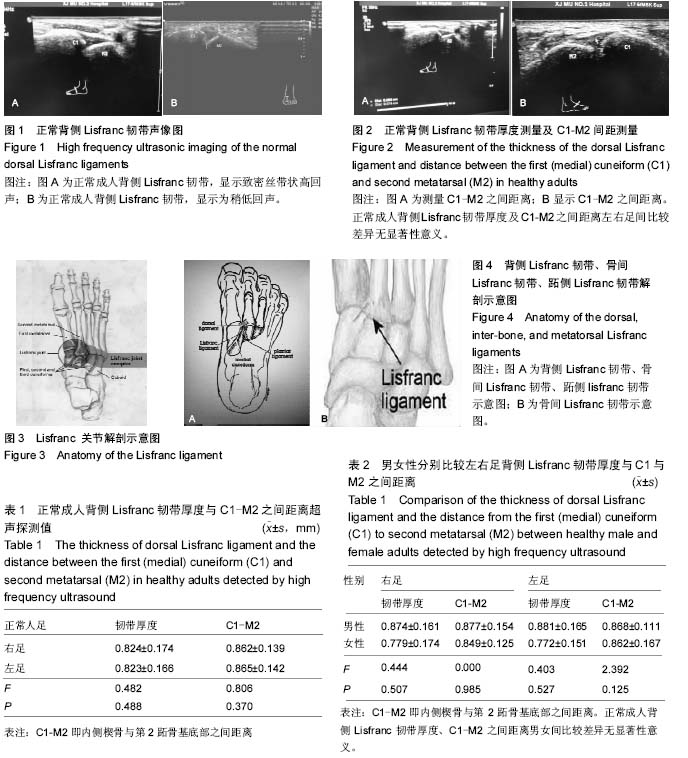| [1] 郑一飞,张洪涛.Lisfranc损伤的诊疗进展[J].中国骨与关节外科,2014,7(4):354-357.
[2] Johnson A, Hill K, Ward J, et al. Anatomy of the Lisfranc ligament. Foot Ankle Spec.2008;1(1):19-23.
[3] Englanoff G, Anglin D, Hutson H. Lisfranc fracture-dislocation: a frequently missed diagnosis in the emergency department. Ann Emerg Med.1995; 26(2): 229-233.
[4] Coetzee JC. Making sense of Lisfranc injuries. Foot xAnkle Clin.2008;13(4): 695-704.
[5] Sands AK, Grose A. Lisfranc injuries. Injury.2004;35 Suppl 2: SB71-76.
[6] Myerson MS, Fisher RT, Burgess AR,et al.Fracture dislocations of the tarsometatarsal joints:end results correlated with pathology and treatment. Foot Ankle. 1986; 6: 225-242.
[7] Goosens M, DeStoop N. Lisfranc’s fracture-dislocations: aetiology, radiology and results of treatment. Clin Orthop Rel Res.1986; 176: 154-162.
[8] Vuori JP, Aro HT. Lisfranc joint injuries: trauma mechanisms and associated injuries. Trauma.1993; 35: 40-45.
[9] Myerson M.The diagnosis and treatment of injuries to the Lisfrane joint complex.Orthop Clin North Am.1989; 20:655-664.
[10] 唐康来,许建中.Lisfranc 关节损伤诊断与处理原则[J].中华创伤杂志,2010,26(12):1060-1062.
[11] 张泽坤,赵静品,吴文娟,等.跗跖关节在常规足平片中的影像学表现[J].河北医药,2011,33(7):1003-1005.
[12] Aronow MS. Joint preserving techniques for Lisfranc jury.Tech Orthopaed.2011;26(1):43-49.
[13] 张泽坤,丁建平,侯志勇,等.跗跖关节骨折脱位的多层螺旋CT特征表现[J].临床放射学杂志,2009,28(8):1126-1129.
[14] Preidler KW, Peicha G, Lajtai G, et al. Conventional radiography, CT, and MR imaging in patients with hyperflexion injuries of the foot: diagnostic accuracy in the detection of bony and ligamentous changes. AJR Am J Roentgenol.1999; 173:1673-1677.
[15] Goiney RC,Connell DG,Nichols DM.CT evaluation of tarsometatarsal fracture-dislocation injuries. AJR Am J Roentgenol.1985; 144:985-990.
[16] Talarico RH, Hamilton GA, Ford LA,et al.Fracture dislocations of the tarsometatarsal joints: analysis of interrater reliability in using the modified Hardcastle classification system. Foot Ankle Surg.2006; 45: 300-303.
[17] 严振国.实用骨伤外科解剖学[M].上海:上海科学技术文献出版社,1992:632-633.
[18] Woodward S,Jacobson J,Femino J,et al.Sonographic evaluation of Lisfranc ligament injuries.Ultrasound Med.2009;28(3):351-357.
[19] Rettedal DD, Graves NC, Marshall JJ, et al. Reliability of ultrasound imaging in the assessment of the dorsal Lisfranc ligament. Foot Ankle Res.2013;6(1):2-7.
[20] 朱跃良,徐永清,丁晶,等.足韧带的解剖学研究及其临床意义[J].中国临床解剖学杂志,2008,26(6):607-611.
[21] Raikin SM,Elias I,Dheer S,et al. Prediction of midfoot in stability in the subtle Lisfranc injury. Comparision of magnetic resonance imaging with intraoperative findings. J Bone Jonint Surg Am.2009;91(4):892-899.
[22] 张泽坤,丁建平,李玉清,等. Lisfranc韧带损伤的多层螺旋CT及MRI表现[J]. 中华放射学杂志,2009,43(12): 1295-1297. |

